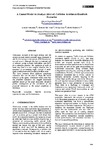A causal model to analyze aircraft collision avoidance deadlock scenarios

Use este enlace para citar
http://hdl.handle.net/2183/25861
Excepto si se señala otra cosa, la licencia del ítem se describe como Atribución-NoComercial-CompartirIgual 4.0 España
Colecciones
Metadatos
Mostrar el registro completo del ítemTítulo
A causal model to analyze aircraft collision avoidance deadlock scenariosAutor(es)
Fecha
2017Cita bibliográfica
Piera Eroles, M. A., Homdedeu, J. de, Tous, M. del Mar, Koca, T., Radanovic, M. A causal model to analyze aircraft collision avoidance deadlock scenarios. En Actas de las XXXVIII Jornadas de Automática, Gijón, 6-8 de Septiembre de 2017 (pp.569-574). DOI capítulo: https://doi.org/10.17979/spudc.9788497497749.0569 DOI libro: https://doi.org/10.17979/spudc.9788497497749
Versiones
http://hdl.handle.net/10651/46832
Resumen
[Abstract] Continuous increase in the traffic density over the certain en-route sectors provokes many situations in which a loss of separation minima (SM) between two aircraft occurs. Although, this loss is predicted well in advance, giving a proper look-ahead time (LAT) for a detection function, the resolution of such an event may lead to a new conflict situation due to dynamics of surrounding traffic aircraft. A multiagent system framework can deal with these cases. This work presents three different complexity indicators that can be used to shape the social behavior of the agents. Simulation results show that the proposed indicators can suggest drastically different nature of the same ecosystem, therefore further investigation of the correlation of the proposed indicators to the actual complexity is necessary.
Palabras clave
Ecosystem
Feasible solutions
Opportunity costs
Conflict maneuvers
Feasible solutions
Opportunity costs
Conflict maneuvers
Versión del editor
Derechos
Atribución-NoComercial-CompartirIgual 4.0 España
ISBN
978-84-16664-74-0 (UOV) 978-84-9749-774-9 (UDC electrónico)






